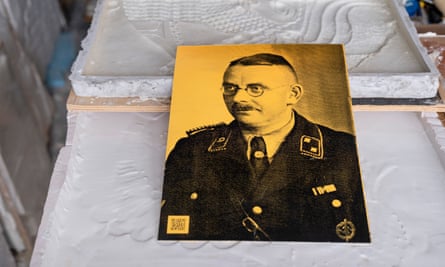A dark chapter in the story of a tiny British island is to be depicted in a reproduction of a Nazi execution site created by an artist whose work explores the impact of destruction and violence.
Piers Secunda has taken a mould of a bullet-damaged wall, part of a Victorian fort on Alderney, one of the Channel Islands, from which he will make a cast to be exhibited in London next month.
This week, Secunda will tell the story of the wall and forensic examination by US experts that supports his conclusion that it was the site of executions carried out by German soldiers who occupied the Channel Islands during the second world war.
His cast will be the latest in a body of work that documents in art form the impact of conflict, a subject Secunda has focused on since 2001 when the Taliban blew up the Buddhas of Bamiyan that were carved into a cliff in Afghanistan in the sixth century.
Secunda was alerted to the existence of the wall in Alderney in 2018 by a friend who lives on the island. “I’ve seen enough bullet impact marks in places like Afghanistan and Iraq to be able to recognise distinct patterns such as invasion, defence, target practice and executions,” he said.
He sought expert opinion from two internationally respected ballistics specialists at John Jay College of Criminal Justice in New York. They visited Alderney last summer, and earlier this month delivered their conclusion that the fort was almost certainly an execution site.
The Channel Islands were occupied by German troops from 1940 until the end of the war. Guernsey and Jersey had large civilian populations, but Alderney’s 1,400 residents had been evacuated just weeks earlier.
The island, just three miles long and 1½ miles wide, is a place of “unimaginable beauty, with sweeping bays of yellow sand, turquoise waters and acres of spectacular wild flowers,” said Secunda.
The evacuation was traumatic. “People were told to kill their livestock and domestic animals, and to pack a single suitcase,.” They had no idea of when, if ever, they would return.
In October 1941, Hitler announced his intention to convert the islands into an “impregnable fortress” to prevent an Allied invasion of Europe. Thousands of prisoners were brought to Alderney to build hundreds of concrete fortifications and labour camps, including two concentration camps run by the SS.

Those sent to the island included Russian, Polish and Ukrainian prisoners of war and civilians, French Jews, and German and Spanish political prisoners. It is thought that more than 6,000 people of 27 nationalities were forced to live and work in brutal conditions.
Immediately after the war, a British intelligence officer, Captain Theodore Pantcheff, investigated German actions on Alderney. “It has been established, I think, that crimes of a systematically brutal and callous nature were committed – on British soil – in the last three years,” he concluded, according to a 2021 report in the Sunday Times.
Prisoners lived on starvation diets in wooden barracks encircled by barbed wire. They “did 12 hours of heavy construction work a day, sometimes more, with a break at midday, varying from 10 minutes to half an hour … this for seven days a week”.

Pantcheff wrote: “Workers were beaten for the most trivial offences, against the harsh regulations, such as failure to execute a drill movement properly, or endeavouring to acquire extra food from the garbage pail.”
One German officer offered soldiers a “bonus of 14 days’ leave, extra food and drink to SS guards for every five dead prisoners”, according to Pantcheff.
Secunda said: “It’s very easy to see why prisoners would be put in front of a wall and shot in large numbers.”
Mass graves were discovered on the island after the war. But the British government decided not to prosecute those responsible for war crimes, fearing an international embarrassment.
Secunda’s interest in the impact of violence stemmed from the 9/11 terror attack on New York’s twin towers. He was living in the Hudson Valley in New York state at the time. “The emotional horror shifted my brain into a different mode in which it became very difficult to focus on making abstract art. I slowly moved towards making work about the destruction of culture.”
With Alderney, there is a personal dimension. His grandfather’s plane was shot at from the islands the night before D-day. “The story of the second world war and what happened at a granular level is still being opened up. A lot is still unknown.”
Many people were unaware that there were concentration camps and German soldiers carried out executions on British soil. “These things actually happened in the UK, and the political dangers are still present in many regards. It’s important to learn from history – and this is an extraordinary lesson.”
Piers Secunda’s lecture, Alderney: an Execution Wall and its Forensic Evidence, is at JW3 in north London, 7.30pm on Wednesday 22 February.
Alderney: The Holocaust On British Soil is at 4 Cromwell Place from 15 March until 15 April.
"artist" - Google News
February 21, 2023 at 02:38PM
https://ift.tt/agoZEvr
Artist reproduces Alderney ‘Nazi execution site’ in London - The Guardian
"artist" - Google News
https://ift.tt/u9R1fdW
Bagikan Berita Ini














0 Response to "Artist reproduces Alderney ‘Nazi execution site’ in London - The Guardian"
Post a Comment